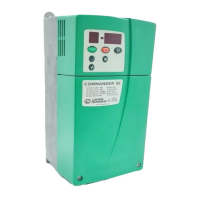
Do you have a question about the Control Techniques COMMANDER SE and is the answer not in the manual?
| Manufacturer | Control Techniques |
|---|---|
| Series | Commander SE |
| Frequency Range | 50/60 Hz |
| Humidity | Up to 95% non-condensing |
| Input Voltage | 200-240VAC, 380-480VAC |
| Control Method | Sensorless Vector Control |
| Communication Protocols | Modbus RTU, CANopen |
| Enclosure Rating | IP20 |
| Protection Features | Overcurrent, Overvoltage, Undervoltage, Overtemperature, Short Circuit |
| Storage Temperature | -40°C to +70°C |
Describes the drive's capability for controlling 3-phase induction motors from 0.25kW to 37kW.
Introduces serial communication capabilities, protocols, and hardware interfaces.
Explains the need for converters and provides examples of EIA232 to EIA485 converters.
Details the SE71 converter for serial communications with Commander SE.
Lists parameters related to Modbus RTU communication settings.
Explains the reasons and methods for performing a drive reset.
Details how to save drive parameters using SE Soft and the Universal Keypad.
Selects the level of the reference being used by the drive for setup and fault finding.
Defines the drive's absolute maximum frequency reference, affecting motor frequency.
Selects the speed reference for motor 1, supporting various input sources.
Selects a preset speed reference, which can be controlled by digital inputs.
Defines the speed reference after the ramps have been applied.
Selects the ramp mode: Fast, Standard Normal, or Standard High motor voltage.
Enables the S-ramp function for smoother acceleration and deceleration profiles.
Selects the acceleration ramp rate based on terminal input or preset reference.
Sets the threshold for detecting zero speed, affecting the 'zero speed' indicator.
Defines the boundary for the 'At speed' indication, influencing the 'At speed' indicator.
Displays the RMS current from each output phase, indicating active and magnetizing components.
Shows the active current, proportional to the y-axis vector, representing amps.
Sets the current limit as a percentage of rated active current.
Selects between normal frequency control (0) and closed loop torque control (1).
Sets the proportional gain for the current controller.
Sets the integral gain for the current controller.
Displays the output frequency of the drive, accounting for current limit and slip compensation.
Defines the motor rated frequency for voltage-to-frequency characteristic.
Sets the motor rated current to the machine nameplate value for rated current.
Selects the autotune mode: none, static, or rotating.
Selects the voltage control mode: vector (0, 1) or fixed boost (2).
Describes behaviour when no motor is connected, leading to an 'rS' trip.
Explains 'rS' trips due to high stator resistance, potentially from incorrect motor/drive configuration.
Details 'rS' trips if required current levels for stator resistance measurement are not met.
Measures stator resistance and voltage offset each start for compensation.
Uses autotune values; does not measure resistance or offset.
Fixed boost mode, using boost voltage defined by 5.15 and 5.09.
Measures resistance/offset on first enable, then changes to mode 1.
Selects the stop mode: Coast, Ramp, DC Injection Braking, etc.
Configures drive behavior during AC supply loss: Disabled, Stop, or Ride through.
Changes terminal functions for start/stop logic, allowing user programmability.
Sets the current level used for injection braking.
Defines the time of injection braking for injection braking stop.
Controls motor speed detection for synchronizing with a spinning motor.
Controls the function of digital input 0 for Run/Forward command.
Controls the function of digital input 1 for Jog command.
Controls the function of digital input 2 for Run/Reverse command.
Controls the function of digital input 3 for Forward/Reverse command.
Controls the function of digital input 4 for Run command.
Configures digital input 5 for the 'Not Stop' function.
Enables latches for run inputs, allowing control from momentary inputs.
Defines which functions can be controlled via serial communications using the control word.
Provides the binary code addition of required operations for drive control via serial comms.
Enables control of the drive via the control word.
Displays the analog signal level at terminal 2, a unipolar voltage input.
Displays analog signal at terminal 5, a unipolar current input.
Monitors heatsink temperature; tripping occurs at 95°C (or 100°C for Size 4).
Defines the parameter controlled by analog input 1.
Configures terminal 5 for different current input ranges.
Defines the parameter controlled by analog input 2.
Selects the source for the analog output on terminal 6.
Offers simple control to change the analog output source via keypad or serial interface.
Indicates terminal state as input or output, affected by logic polarity.
Indicate the input state of terminals 9 through 13.
Defines the parameter controlled by digital input 1 or the source for digital output 1.
Defines the parameter controlled by digital input 2.
Sets the mode of operation for the serial port (ANSI, Modbus RTU, F.bus).
Allows copying parameter set-ups between drives using Quickey.
Activates the second motor parameter set when set to 1.
Enables the PID controller to operate.
Defines the motor rated frequency for motor 2.
Sets the motor rated current for motor 2.
Sets the motor rated voltage for motor 2.
Activates the second motor map when set to 1.
Shows power terminal connections for Commander SE Sizes 1, 2-4, and 5.
Shows derating curves for Commander SE Size 1 drives (0.55kW and 0.75kW).
Shows derating curves for Commander SE Size 4, 11kW drive.
Shows derating curves for Commander SE Size 4, 15kW drive.
Shows derating curves for Commander SE Size 5, 22kW drive.
Explains how to connect digital inputs of multiple drives in parallel from a single source.
Details how parameters 6.04 and 1.14 automatically change terminal functions.
Details how to re-assign the analog output on terminal 6, e.g., for DC bus voltage.
Explains how to re-assign analog inputs for controlling current limit or speed reference.
Describes how to set user-defined trips.
Explains how to set up terminal 13 as a motor thermistor input.
Details a non-safety critical brake control setup using logic functions and outputs.
Explains standard ramp mode (Parameter 2.04 = 1) and voltage behavior during deceleration.